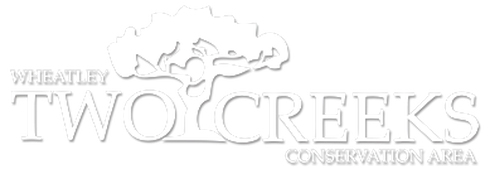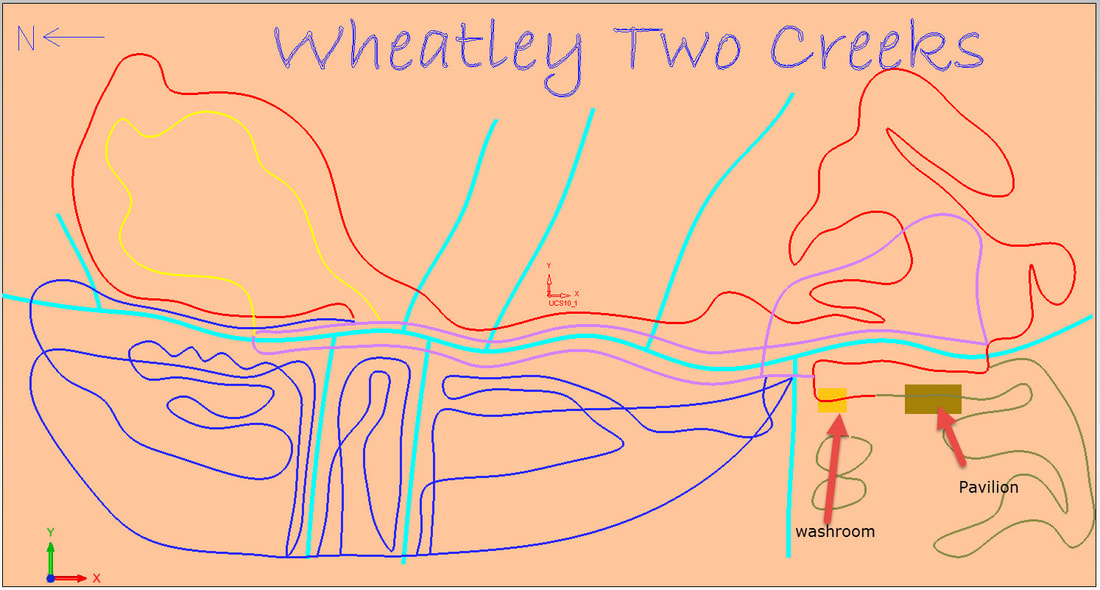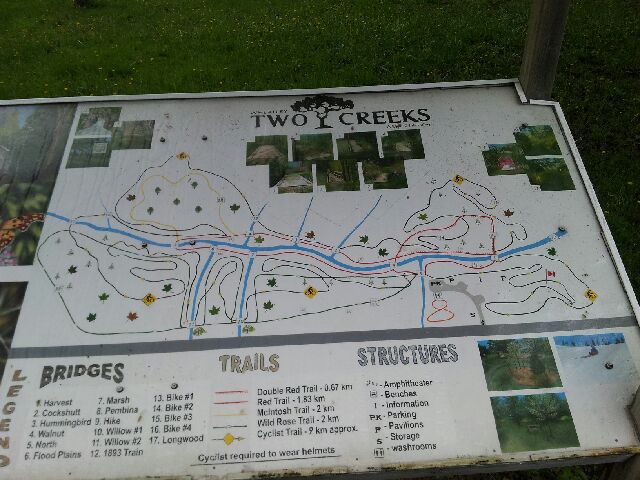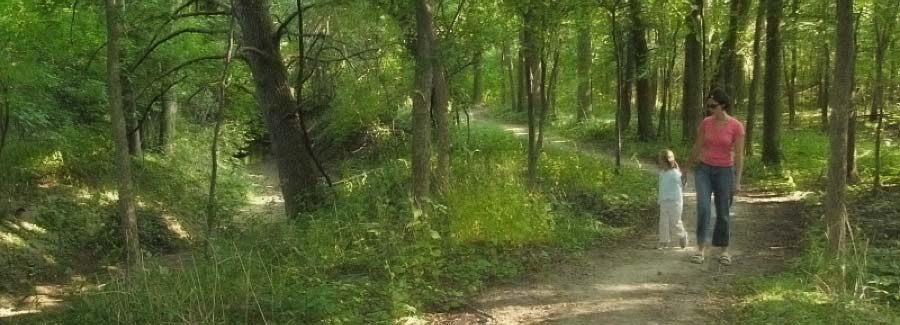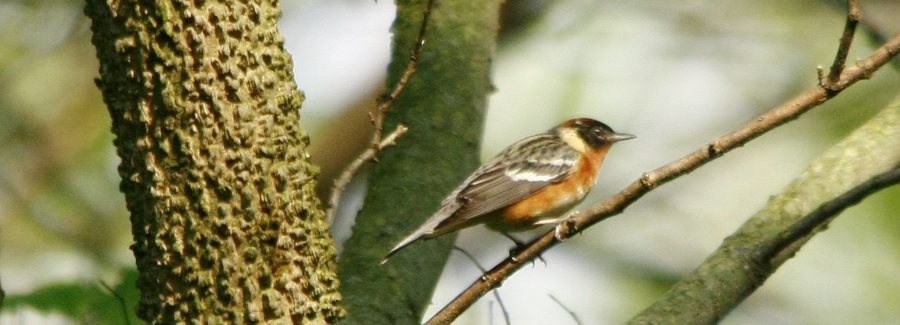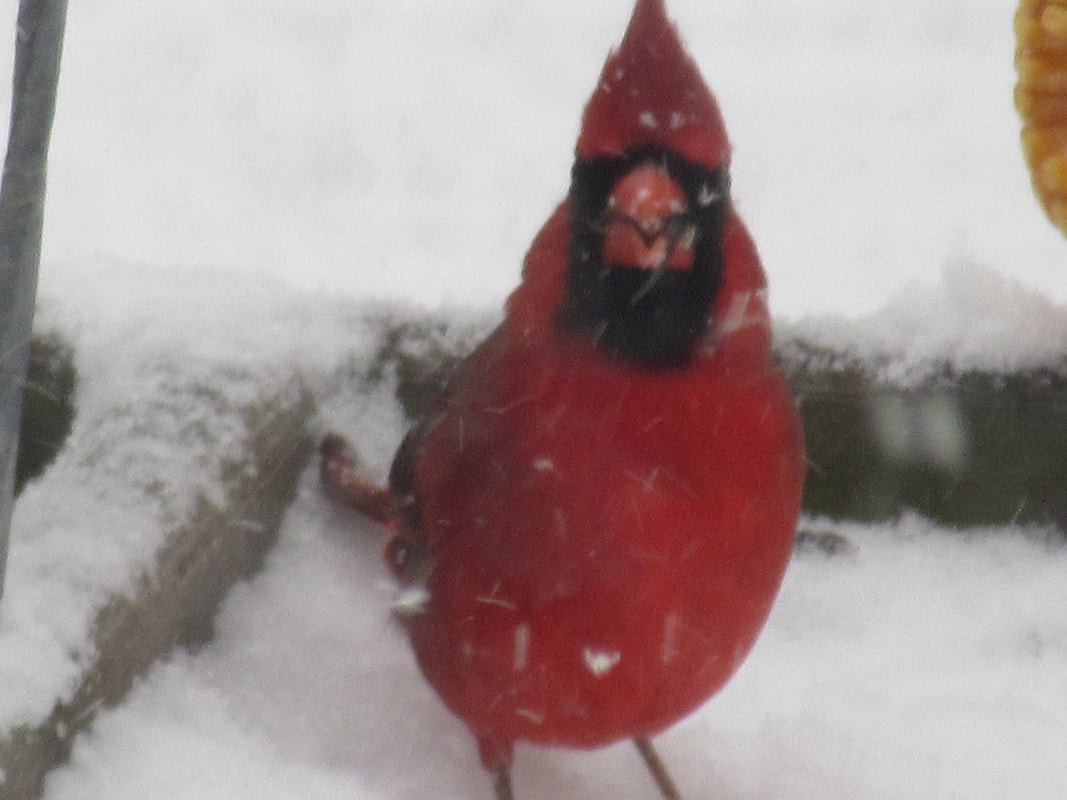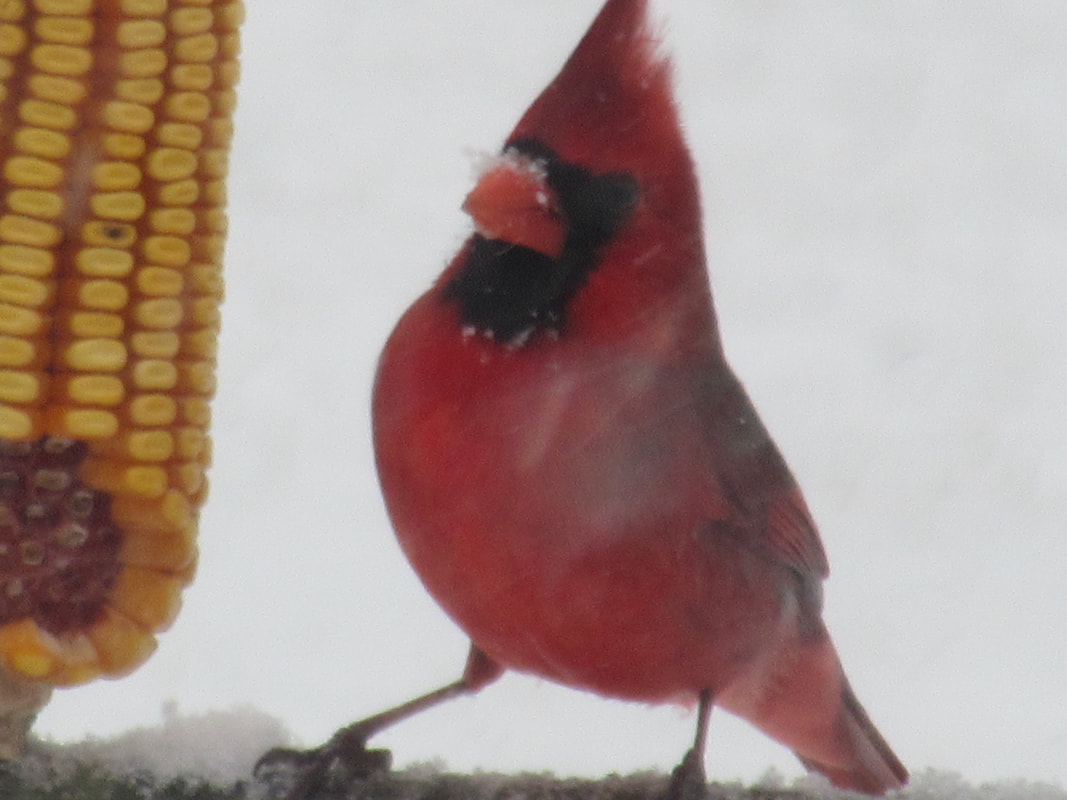Nature Trails
A trail map is located near the large pavilion, showing various options for both walking and cycling. Cycling trails are marked with a triangle, and are quite narrow. It is encouraged that you do not walk on cycling trails, at least during cycling season, so as to avoid collisions between cyclists and walkers.
The longer walking trails travel up and down hills through secluded woodland and cross numerous foot bridges over meandering creeks before reaching the open grassland area. For a more rigorous workout, the extensive mountain-bike trails provide a challenge and are maintained by the Rocket Mountain Biking Club of Essex and Kent counties. There are trails to suit everyone at Two Creeks, whether young or old or preferring to walk or ride. You can walk for hours, or take a ten minute walk with a variety of difficulty in each.
Here are some suggestions.
Two short walks.
The first one to the 1897 railway bridge. Walk past the stage. Do not cross the Harvest Bridge. Follow the trail along the creek to the classic old bridge. Quite beautiful. Walk back. 10 minutes.
Second short walk. Cross the Harvest Bridge. Turn left. Follow this trail through the evergreens to the Pearce Bridge. Cross it. Go up the gentle slope. Then turn left. Cross the red Hike Metal Bridge. You are back to the parking lot. 10 minutes.
A gentle walk. The Wild Rose Trail. White arrows. Can be 20, 30 or 50 minutes long. It is shaped like the letter B but with three loops, with the straight back paralleling the road. One loop is 20 minutes, two is 30, all three is 50. Begin by crossing the red Hike Metal Bridge. Go straight ahead. You will see the sign and the arrow. When you get to the straight back of the B, you can turn right and cross the footbridge through the Weeping Willows and begin the second loop on your right or you can turn left and walk through the Memorial Groves and back to the start. The third loop begins at the next Weeping Willow crossing. Hardwoods. Pine woods. Grass lands. Wet lands.
A more demanding walk. Many landscapes. Quite a bit of climbing. The Red Circle Trail. This trail hugs the creek and is shaped like a long loop. About 45 minutes. Begin by crossing the blue Harvest Bridge past the stage. Turn right and then left. Take the trail up to the pine grove and follow the red arrows. You will go through the grove and then descend to the creek. Keep to the right. Do not get sidetracked by cycling trails. Go past the Pearce Bridge. You will cross the Cockshut Bridge, the Hummingbird Crossing, and the Walnut Bridge. You will note the McIntosh Trail with yellow markers looping to the right off the Red Circle Trail. This is a 25 minute loop which passes through a Hickory and Oak Savannah. It rejoins the Red Circle farther on. You may wish to save it for another walk. Continue along the Red Circle Trail until you reach the North Bridge. Cross it. Turn left. You are now headed back. You will cross the Floodplains Bridge and the Marsh Bridge and finally the red Hike Metal Bridge. Voila. Your car.
As you become more familiar with the park, you will find other linking trails. Enjoy.
The longer walking trails travel up and down hills through secluded woodland and cross numerous foot bridges over meandering creeks before reaching the open grassland area. For a more rigorous workout, the extensive mountain-bike trails provide a challenge and are maintained by the Rocket Mountain Biking Club of Essex and Kent counties. There are trails to suit everyone at Two Creeks, whether young or old or preferring to walk or ride. You can walk for hours, or take a ten minute walk with a variety of difficulty in each.
Here are some suggestions.
Two short walks.
The first one to the 1897 railway bridge. Walk past the stage. Do not cross the Harvest Bridge. Follow the trail along the creek to the classic old bridge. Quite beautiful. Walk back. 10 minutes.
Second short walk. Cross the Harvest Bridge. Turn left. Follow this trail through the evergreens to the Pearce Bridge. Cross it. Go up the gentle slope. Then turn left. Cross the red Hike Metal Bridge. You are back to the parking lot. 10 minutes.
A gentle walk. The Wild Rose Trail. White arrows. Can be 20, 30 or 50 minutes long. It is shaped like the letter B but with three loops, with the straight back paralleling the road. One loop is 20 minutes, two is 30, all three is 50. Begin by crossing the red Hike Metal Bridge. Go straight ahead. You will see the sign and the arrow. When you get to the straight back of the B, you can turn right and cross the footbridge through the Weeping Willows and begin the second loop on your right or you can turn left and walk through the Memorial Groves and back to the start. The third loop begins at the next Weeping Willow crossing. Hardwoods. Pine woods. Grass lands. Wet lands.
A more demanding walk. Many landscapes. Quite a bit of climbing. The Red Circle Trail. This trail hugs the creek and is shaped like a long loop. About 45 minutes. Begin by crossing the blue Harvest Bridge past the stage. Turn right and then left. Take the trail up to the pine grove and follow the red arrows. You will go through the grove and then descend to the creek. Keep to the right. Do not get sidetracked by cycling trails. Go past the Pearce Bridge. You will cross the Cockshut Bridge, the Hummingbird Crossing, and the Walnut Bridge. You will note the McIntosh Trail with yellow markers looping to the right off the Red Circle Trail. This is a 25 minute loop which passes through a Hickory and Oak Savannah. It rejoins the Red Circle farther on. You may wish to save it for another walk. Continue along the Red Circle Trail until you reach the North Bridge. Cross it. Turn left. You are now headed back. You will cross the Floodplains Bridge and the Marsh Bridge and finally the red Hike Metal Bridge. Voila. Your car.
As you become more familiar with the park, you will find other linking trails. Enjoy.
Birding
Located on the eastern side of Point Pelee, Two Creeks enjoys some of the best birding during the spring and fall migrations, and provides a habitat for ring-necked pheasants, bobwhite quail and woodcocks. Common breeding birds include bobolink, meadowlark, Baltimore orioles, yellow and yellow-rumped warblers and willow flycatchers. Fall migrants can include any and all of the returning warblers, with northern saw-whet owls making regular appearances.
